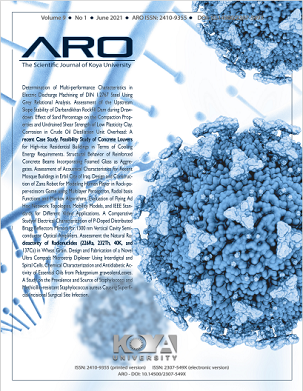Chemical Characterization and Antidiabetic Activity of Essential Oils from Pelargonium graveolens Leaves
DOI:
https://doi.org/10.14500/aro.10791Keywords:
Pelargonium graveolens, Geranium, Geraniaceae, Diabetes, Gas chromatography–mass spectrometry, α-Glucosidase enzymeAbstract
Pelargonium graveolens (Geranium) is a source of the finest quality of fragrance and its essential oils are used as antibacterial, and antifungal agents. The aim of the current research is to determine chemical constituents in the essential oil of P. graveolens by GC-MS and evaluate its antidiabetic activity via α-glucosidase inhibition assay. The chemical composition of P. graveolens essential oil was determined by GC/MS and its antidiabetic activity was assessed through inhibition of α-glucosidase enzyme in in-vitro models. GC-MS analysis determines 36 chemical components in the essential oil of P. graveolens leaves, and citronellyl isovalerate (10.41 %), menthol (9.61 %), linalool (8.63 %), p-menthone (6.31 %), and geranyl tiglate (4.99 %) were recorded as major constituents. The essential oil of P. graveolens leaves showed concentration dependant inhibition of α-glucosidase enzyme ranging from 28.13±1.41 to 74.24±2.53 µg/mL for concentration ranging from 31.25 to 1000 µg/mL. The IC50 values for of P. graveolens and acarbose were found as 93.72±4.76 and 80.4±2.17 µg/mL, respectively against the α-glucosidase enzyme. The study finding explores the chemical components of P. graveolens growing in the Iraqi Kurdistan region and scientifically supported its possible use in diabetic patients for controlling postprandial hyperglycemia.
Downloads
References
Abd El-Kareem, M.S.M., Rabbih, M.A., Elansary, H.O. and Al-Mana, F.A., 2020. Mass spectral fragmentation of Pelargonium graveolens essential oil using GCMS semi-empirical calculations and biological potential. Processes, 8, p.128.
Adams, R.P., 2007. Identification of Essential Oil Components by Gas Chromatography/Mass Spectrometry. 4th ed. Allured Publishing, Carol Stream, IL, USA.
Ahamad, J., Alkefai, N.H.A., Amin, S. and Mir, S.R., 2020. Standardized extract from Enicostemma littorale ameliorates post-prandial hyperglycaemia in normal and diabetic rats. Journal of Biologically Active Products from Nature, 10(1), pp.34-43.
Ahamad, J., Hasan, N., Amin, S. and Mir, S.R., 2016. Swertiamarin contributes to glucose homeostasis via inhibition of carbohydrate metabolizing enzymes. Journal of Natural Remedies, 16(4), pp.125-130.
Ahamad, J., Naquvi, K.J., Mir, S.R. and Ali, M., 2011. Review on role of natural alpha-glucosidase inhibitors for management of diabetes mellitus. International Journal of Biomedical Research, 6, pp.374-380.
Ahamad, J., Toufeeq, I., Khan, M.A., Ameen, M.S.M., Anwer, E.T., Uthirapathy, S., Mir, S.R. and Ahmad, J., 2019. Oleuropein: A natural antioxidant molecule in the treatment of metabolic syndrome. Phytotherapy Research, 33(12), pp.3112-3128.
Ahamad, J., Uthirapathy, S., Ameen, M.S.M. and Anwer, E.T., 2019. Essential oil composition and antidiabetic, anticancer activity of Rosmarinus officinalis L. leaves from Erbil (Iraq). Journal of Essential Oil Bearing Plants, 22(6), pp.1544-1553.
Ali, M., 2001. Techniques in Terpenoid Identification. Birla Publication, New Delhi, India, pp.4-51.
Alkefai, N.H., Ahamad, J., Amin, S. and Mir, S.R., 2018. Arylated gymnemic acids from Gymnema sylvestre R.Br. as potential α-glucosidase inhibitors. Phytochemistry Letters, 25, pp.196-202.
Alkefai, N.H., Sharma, M., Ahamad, J., Amin, S. and Mir, S.R., 2019. New olean15-ene type gymnemic acids from Gymnema sylvestre (Retz.) R.Br. and their antihyperglycemic activity through α-glucosidase inhibition. Phytochemistry Letters, 32, pp.83-89.
Bhattacharya, A.K., Kaul, P.N., Rajeswara, B.R.R., Ramesh, S.I. and Mallavarapu, G.R., 1993. Composition of the oil of rose-scented Geranium (Pelargonium sp.) grown under the semiarid tropical climate of South India.Journal of Essential Oil Research, 5(2), pp.229-231.
Dong, H.Q., Li, M., Zhu, F., Liu, F.L. and Huang, J.B., 2012. Inhibitory potential of trilobatin from Lithocarpus polystachyus rehd against α-glucosidase and α-amylase linked to Type 2 diabetes. Food Chemistry, 130, pp.l261-66.
Fabricant, D.S. and Farnsworth, N.R., 2001. The value of plants used in traditional medicine for drug discovery. Environmental Health Perspectives, 109(1), pp.69-75.
Gin, H., and Rigalleau, V., 2000. Post-prandial hyperglycemia and diabetes. Diabetes and Metabolism, 26, pp.265-272.
Lis-Balchin, M., Buchbauer, G., Ribisch, K. and Wenger, M.T., 1998. Comparative antibacterial effects of novel Pelargonium essential oils and solvent extracts. Letters in Applied Microbiology, 27(3), pp.135-141.
Lis-Balchin, M., Steyrl, H. and Krenn, E., 2003. The comparative effect of novel Pelargonium essential oils and their corresponding hydrosols as antimicrobial agents in a model food system. Phytother. Phytotherapy Research, 17(1), pp.60-65.
Miller D.M., 2002. Geranium and Pelargonium. In: Lis-Balchin, M., Ed. Medicinal and Aromatic Plants-Industrial Profiles. Taylor and Francis, London, UK, p.49.
Pattnaik, S., Subramanyam, V.R. and Kole, C.R., 1996. Antibacterial and antifungal activity of ten essential oils in vitro. Microbios, 86, p.237.
Pattnaik, S., Subramanyam, V.R., Bapaji, M. and Kole, C.R., 1997. Antibacterial and antifungal activity of aromatic constituents of essential oils. Microbios, 89(358), pp.39-46.
Rajeswara, B.R.R., Kaul, P.N., Mallavarapu, G.R. and Ramesh, S., 1996. Effect of seasonal climatic changes on biomass yield and terpenoid composition of rose-scented geranium (Pelargonium species). Biochemical Systematics and Ecology, 24(7-8), pp.627-635.
Rana, V.S., Juyal, J.P. and Blazquez, M.A., 2002. Chemical constituents of essential oil of Pelargonium graveolens leaves. International Journal of Aromatherapy, 12(4), pp.216-218.
Scheen, A.J. 2003. Is there a role for α-glucosidase inhibitors in the prevention of Type 2 diabetes mellitus? Drugs, 63, pp.933-951.
Subramanian, R., Asmawi, M.Z. and Sadikun, A., 2008. In-vitro α-glucosidase and α-amylase enzyme inhibitory effects of Andrographis paniculata extract and andrographolide. Acta Biochimica Polonica, 55(2), pp.391-398.
Downloads
Published
How to Cite
Issue
Section
License
Authors who choose to publish their work with Aro agree to the following terms:
-
Authors retain the copyright to their work and grant the journal the right of first publication. The work is simultaneously licensed under a Creative Commons Attribution License [CC BY-NC-SA 4.0]. This license allows others to share the work with an acknowledgement of the work's authorship and initial publication in this journal.
-
Authors have the freedom to enter into separate agreements for the non-exclusive distribution of the journal's published version of the work. This includes options such as posting it to an institutional repository or publishing it in a book, as long as proper acknowledgement is given to its initial publication in this journal.
-
Authors are encouraged to share and post their work online, including in institutional repositories or on their personal websites, both prior to and during the submission process. This practice can lead to productive exchanges and increase the visibility and citation of the published work.
By agreeing to these terms, authors acknowledge the importance of open access and the benefits it brings to the scholarly community.
Accepted 2021-06-22
Published 2021-06-30
















 ARO Journal is a scientific, peer-reviewed, periodical, and diamond OAJ that has no APC or ASC.
ARO Journal is a scientific, peer-reviewed, periodical, and diamond OAJ that has no APC or ASC.